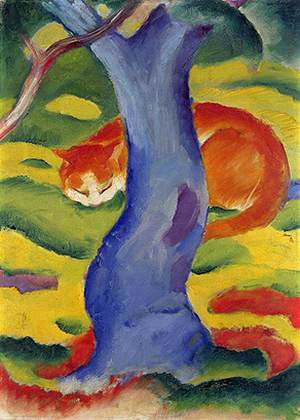Franz Marc, the German Expressionist painter (1880 - 1916) made hundreds of drawings and paintings of cats during his working life
He followed the example of his grandparents, both amateur artists, in copying the works of the great artists as a means to learn and to improve his own work.
This painting, Cat Behind a Tree, is also known as Children's Picture. It was painted in oil on canvas in 1910/11.
The majority of Marc's paintings are of animals. He was interested in their spiritual nature and usually depicted them in a natural environment. He shows them behaving naturally, washing and sleeping, but they often have a dreamlike quality in his paintings.
Cat Behind a Tree has a most unusual composition which breaks all the conventional rules. A bright blue tree placed directly in the centre of the canvas cuts the picture in half. The main subject of the picture, the sleeping cat, is half-hidden behind it but is also right in the middle of the picture plane.
As a student in Germany and, later, in Paris, Marc was strongly influenced by Cezanne, Van Gogh and Gaugin. In 1910 he met and formed close friendships with Wassily Kandinsky and Auguste Macke.
The influence of all these painters can be seen in Marc's choice of colours in this painting. In addition, to Franz Marc, blue represented masculinity and yellow femininity. Here we see the strong blue tree dominating the image whilst the ginger cat sleeps serenely in a golden yellow field behind it.
The clear and almost primary colours may be one of the reasons for the painting's alternative name, but no-one really knows whether it was painted with children in mind.
Until fairly recently the painting was in the Sprengel Museum in Hanover. In 2009 it was returned to the family of its previous owner Alfred Hess.




